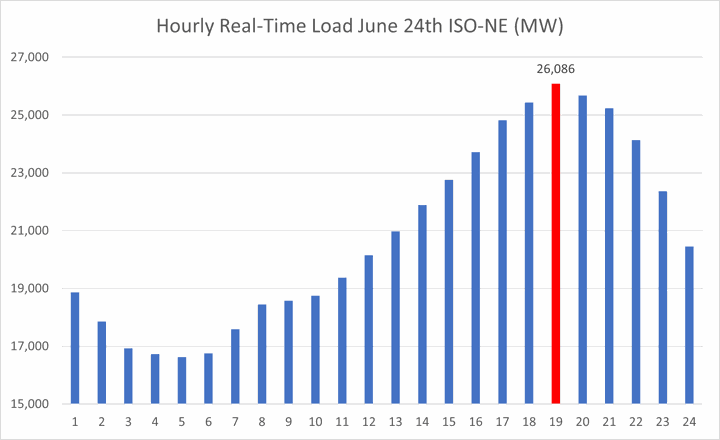
By Andrew Price, President & CEO
There was little suspense as we waited for the Independent System Operator of New England (ISO-NE) to formally identify the annual peak load for 2025. Temperatures on June 24 hit 100 degrees Fahrenheit across much of New England and electricity demand spiked to the highest level since 2013, as air conditioners struggled to keep pace. ISO-NE released its preliminary Annual System Peak Day, Hour & Load report on October 20 and, as expected, the report lists the 6:00 to 7:00 PM hour on June 24 as the peak, with load at 26,086 MW.
Having an early summer heatwave in June, with a historically high peak demand, made a relaxed summer for the Self-Help Program team here at CES. In a more typical summer, it is common to have many moderately hot days with very similar peak loads, necessitating consistent vigilance and decision points for CES - about whether to issue a Self-Help alert - and for our clients - about the value of disrupting operations to reduce electric load. With a high bar set so early this year, we only needed to issue a curtailment recommendation for the single day, June 24. I know our many clients in the CES Self-Help program appreciated being able to operate without interruption for the remainder of the summer.
As we mention frequently, peak load information is subject to change by ISO-NE as new data becomes available and adjustments are made. This is one reason that CES Self-Help notices typically recommend a curtailment window spanning several hours. Our recommendation to participants for June 24 was to curtail loads starting at 4:00 PM continuing until 9:00 PM. We also provided a more targeted window focused on 5:00 - 8:00 PM for anyone that found a five-hour curtailment difficult.
In addition to after-the-fact adjustments from ISO-NE, other factors make it difficult to predict the peak load hour with precision. These factors include: the influence of hundreds of individual companies responding (or not responding) to load curtailment notices throughout the region; the location and timing of summer thunderstorms; and the impact of the rapidly growing number of behind-the-meter solar PV facilities during late afternoon hours when solar pv generation falls off quickly.
The following chart shows hourly loads for June 24. The 6:00 PM to 7:00 PM hour (Hour 19) is the clear winner at just over 26,000 MW with the 7:00 PM to 8:00 PM hour (Hour 20) around 200 MW lower.

As a reminder, ISO-NE assigns every retail electricity account in New England a capacity tag based on its load during the hour of annual peak the prior year. The capacity tag is the contribution of each electric utility account to overall system demand during the single annual hour of peak load. This value (measured in MW) divided by the total load in New England during that hour represents that account's share of the roughly $1 to $2 billion in capacity payments ISO-NE makes each year to the region's electricity generators. If you can predict the hour when the annual system peak occurs, and are able to reduce your load that hour, you will have a smaller capacity tag and therefore be responsible for a smaller share of the total amount paid to generators. This is taken into consideration by electricity suppliers in quoting prices to serve your account, so a lower capacity tag will result in lower electricity costs the next year.
Account level capacity tags set during calendar 2025 will be used to determine your capacity costs during the power year running June 2026 through May 2027. The capacity market in New England will work the same way in 2026 (the peak hour in calendar year 2026 will determine your costs for the June 2027 through May 2028 power year) but changes are coming, starting June 2028.
Over the next 12-24 months, ISO-NE and other stakeholders will be considering significant changes to the capacity market. Changes are likely to include a transition away from using a single peak hour to a system that considers both winter and summer peak hours. This change is being made as winter peak loads are expected to grow in New England. The adoption of efficient heat pumps as the preferred method of space heating is expected to push the winter peak higher than the summer peak sometime in the 2030s.
Additional changes to the capacity program are expected to impact the capacity value that generators are assigned based on their probability of generating at a given capacity level during system peak hours. Generators using natural gas, oil, solar, wind and hydro may all be assigned different capacity values starting in 2028.
Other regions of the U.S. have undertaken similar changes to regional capacity programs and experienced dramatic increases in capacity prices. Regional electric grid operators for the mid-Atlantic states (PJM) and the mid-continent states (MISO) both implemented similar changes to their capacity accreditations methodology. Both regions also set capacity based on seasonal peaks (MISO) or over multiple peak hours (PJM).
The PJM capacity market experienced more than an 800% increase in capacity rates in 2025 and will see an additional 22% increase for 2026. The MISO capacity rates witnessed more than a 600% increase in 2025.
New England may not experience a spike as large as MISO or PJM but we expect capacity prices to increase in 2028, perhaps significantly, from current levels. For CES clients participating in our ISO-NE Self-Help program, we encourage you to think about how you might reduce load during winter peak hours in addition to the traditional summer peak hour. Winter peaks are expected to occur in the morning, as homes and businesses turn up the heat from overnight setbacks and before solar PV has ramped to full capacity. Summer peaks are still expected to occur in the late afternoon, as air conditioners deal with the heat from the day and solar PV is ramping down.
The CES Self-Help program is always voluntary and without fees for our clients. There is never any obligation to respond to our notifications and, if you can respond during the hour of the ISO-NE system peak, 100% of any savings are yours to keep. If you wish to enroll (or unenroll) from our program – or have any feedback for us about the program – you can let us know by contacting your CES Energy Services Advisor or Nina Callanan @ ncallanan@competitive-energy.com.
Photo by Lamyai
